
Page 43: of Maritime Reporter Magazine (December 15, 1973)
Read this page in Pdf, Flash or Html5 edition of December 15, 1973 Maritime Reporter Magazine
Drewry Report Covers
VLCC Employment
And Transshipment
The rapidly growing number and size of very large crude carriers (VL'CCs) is forcing companies en- gaged in >the oil transportation in- dustry ito reconsider traditional at- titudes and practices. By 1977, 50 percent of the world tanker fleet (in terms of deadweight tons) will probaibly be vessels over 150,000 dwt. Whereas 250,000 dwt was considered the maximum standard size of crude carriers only a short time ago, orders for standard 400,- 000-dwt vessels are now being placed every week. Oil companies are increasingly resorting to such practices as lightening at sea, transshipment, and even multipoint discharging as a means of over- coming restrictions, not only on the maximum vessel size, but also on the location for new develop- ments from environmentalists and governments.
The H.P. Drewry (Shipping
Consultants) Limited report begins with a comprehensive study of
VLCC terminal facilities through- out the world, updating information contained in the previous Shipping
Study No. 3, "Terminal Facilities for VLCCs," published in Febru- ary 1972. The strong competition between Rotterdam and LeHavre for Northwest Europe's very lucra- tive hinterland oil (trade is one of the developments noted since the last report. LeHavre is building a 500,000-dwt terminal at 'Cape Anti- fer for completion in 1975, whereas
Rotterdam will probably go ahead with its plan to build a 280,000-dwt terminal at Maasvllakte. In the
United States, competition to build the first U.S. superport is very keen, but the contestants not only have to fight rival plans, but also the strong environmental lobby.
Drewry believes that the USA could have a superport in the U.S.
Gulf by 1976-77. The environ- mental lobby will probably pre- vent s'uperports being built on the
U.S. East Coast in the foreseeable future. In Japan, considerable in- terest is being shown in the devel- opment of offshore Japanese trans- shipment terminals.
In the second part of the report, they examine the alternative meth- ods of employing VLCGs and dis- cuss the advantages and disadvan- tages of lightening, two-port dis- charging and transshipment. His- torical details of the European op- erations of the six specially con- verted lightening vessels are given from tracking records. Three of the tankers are owned by Shell, two by Exxon and one by BP.
In ithe last part of this report, all current and proposed crude oil transshipmenit facilities are dis- cussed in detail. Historical crude oil movements from such trans- shipment ports as Bantry Bay,
Rotterdam, LeHavre and Kiiire are given. Of the considerable number of proposed developments of trans- shipment terminals throughout the world, of particular interest are facilities being built in the Carib- bean for the U.S. market. Most of the major oil companies already have, or are developing in the
Western Hemisphere, VLCC facili- ties suitable for transshipment to the U.S.
Comprehensive listings of all world current and proposed VLCC loading and discharge facilities are given, and the locations of these ports are shown on maps and how they connect to crude oil fields and refining areas. ^Because of the in- creasing importance of transship- ment terminals, a comprehensive listing is also given covering the reported cost, throughput, location, •etc. of these facilities. "Transhipment Terminals and
VLCC Employment," No. 15 in a series of reports prepared by the
Research Division of H.P. Drewry (Shipping Consultants) Limited, 87-91 New Bond Street, London
W1Y, 9LA, England, is available on a subscription basis (£40 per ten reports, about $96) or a single copy rate of £10, about $24.
Virginia Sun/N.Y. Sun
File CDS To Build 2 380,000-Dwt Tankers
Two subsidiaries of the Marine In- vestment Company of Delaware—
Virginia Sun Shipping Co., Inc., and
New York Sun Shipping, Inc.—have filed a construction differential Sub- sidy application to assist in building two 380,000-deadweight-ton tankers, one for each company. No builder has been selected for the vessels, which will cost approximately $110 million each.
Ocean Systems
Several major programs in undersea and surface activities, including surface effects ships, have created a number of new positions at Lockheed Missiles and Space Company for engineers, scientists and naval architects.
Marine Electrical Engineers
Naval Architecture Engineers
Electrical Design Engineers
Stress Research Engineers
Senior Engineering Draftsmen
Structures Design Engineers
Propulsion Systems Design Specialists
Materials and Processes Research Engineers
Weight Engineers
Inflatable Structures Design Specialists
Hydro Research Engineers
Test Research Engineers
Performance and Simulation Research Engineers
These positions are in the Ocean Systems Division which was established in 1971 as part of Lockheed's growing commitment to oceanic endeavors. Inquiries are invited from those possessing a high level of ability. Please address Professional Placement Manager, 1184 North Mathilda, Sunnyvale, Ca. 94088. Lockheed is an equal opportunity F/M employer.
LOCKHEED
Missiles & Space Company, Inc.
December 15, 1973 43

 42
42

 44
44
